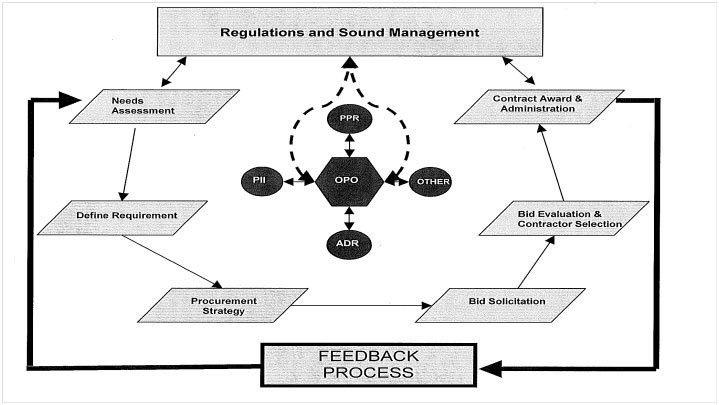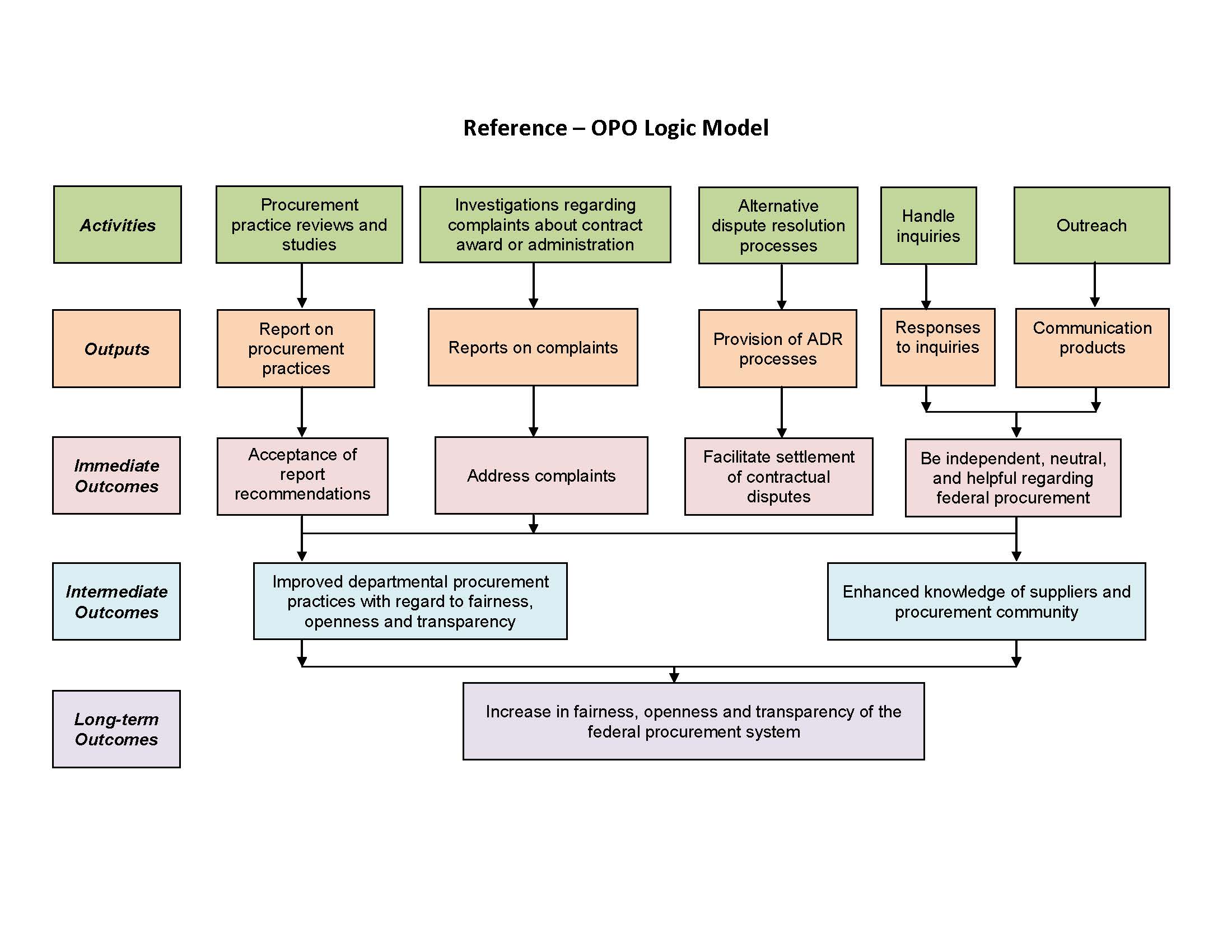Profile of the Office of Procurement Ombudsman
This chapter provides a brief profile of the Office of the Procurement Ombudsman.
A. Context
The Financial Administration Act states that the Government of Canada is committed to taking appropriate measures to promote fairness, openness and transparency in the bidding process for contracts with Her Majesty for the performance of work, the supply of goods or the rendering of services. In this context, the federal government's objective, as stated in Treasury Board of Canada's Contracting Policy, is to acquire goods and services and carry out construction in a manner that enhances access, competition and fairness, and results in best value or overall benefits to the Crown and the Canadian people.
Over the years, procurement has become increasingly complex. There are more than 15 Acts of Parliament, a number of Regulations, and over 36 different policies related to procurement. There are also many key players involved, with various roles and responsibilities -- including Treasury Board, operating and program departments, the Department of Justice, and Public Works and Government Services Canada as a common service organization for contracting.
After the inquiry into the "sponsorship program", the 2006 Speech from the Throne stated "no aspect of responsible government is more fundamental than having the trust of citizens. Canadians' faith in the institutions and practices of government has been eroded…. It is time for accountability." The "sponsorship program" and the controversies that surrounded it compelled the Government to respond to public concerns by introducing several new initiatives, including a new Management Accountability Framework and guidance for Deputy Ministers.
In 2003, an interdepartmental Task Force was put in place to carry out a government-wide review of procurement. The Task Force aimed to find a balance wherein procurement could be faster, simpler, and more effective, and continue to provide the openness and transparency demanded by the Canadian public. The Task Force made recommendations for a procurement system that demonstrates transparency, accountability and fiscal responsibility. One of the Task Force's recommendations was "the government should consider the potential need for a body to provide advice and oversight to provide increased transparency on the management of the government's procurement process and insight on evolution in the procurement community of practice". It was these initiatives plus the 2006 Federal Accountability Act, and subsequent amendments to the Department of Public Works and Government Services Act that led to creating the position of Procurement Ombudsman.
In 2007, the Government announced that OPO's work will enhance procurement practices across government by ensuring that the highest standards of ethical conduct are followed. This will increase Canadians' confidence in the accountability and transparency of federal procurement activities.
B. Mandate
The Office of the Procurement Ombudsman became fully operational after the Procurement Ombudsman Regulations came into effect in May 2008. The mandate of the OPO is to:
- Review the practices of departments for acquiring material and services to assess their fairness, openness and transparency and make any appropriate recommendations to the relevant department for the improvement of those practices;
- Review any complaint respecting the compliance with any regulations made under the Financial Administration Act of the award of a contract for the acquisition of materiel or services by a department to which the Agreement, as defined in section 2 of the Agreement on Internal Trade Implementation Act, would apply if the value of the contract were not less than the amount referred to in article 502 of that Agreement;
- Review any complaint respecting the administration of a contract for the acquisition of materiel or services by a department; and
- Ensure that an alternative dispute resolution (ADR) process is provided, on request of each party to such a contract.
The Procurement Ombudsman shall also perform any other duty or function respecting the practices of departments for acquiring materiel and services that may be assigned to the Procurement Ombudsman by order of the Governor in Council or the Minister. The Procurement Ombudsman reports directly to the Minister of Public Works and Government Services Canada (PWGSC) and is required to submit an annual report, which the Minister tables in Parliament.
C. OPO's Role in the Federal Procurement Process
The government procurement challenge and oversight function is a key component of the broader set of management controls that are used to ensure the sound management of government procurement. The following figure depicts the federal procurement process and the central role that OPO is expected to play in enhancing the process to review complaints (depicted as PII in Figure 2.1) and review procurement practices (depicted as PPR).
Figure 2.1 : OPO's Role in the Federal Procurement Process

A description of OPO's Role in the Federal Procurement Process is available on a separate page.
D. Objective
The objective of the OPO is to improve the fairness, openness and transparency in federal government procurement.
E. Stakeholders
The OPO has defined the following three principal stakeholder groups:
- Suppliers - These are Canadian firms and individuals who do or have the potential to provide goods and services to the federal government. From OPO's perspective, there are several sub-groups of suppliers including the following:
- Those who have provided goods and services;
- Those who have lodged an inquiry or complaint with the OPO; and
- Those who have been involved in OPO's ADR process.
This also includes supplier associations as they have a broader perspective on the procurement system and a focus on the overall health of the system.
- Federal Government Departments – Public servants, both procurement specialists and program managers, who are involved in the procurement of goods and services. There are those who have:
- Been involved in OPO procurement practice reviews;
- Been involved in dealing with inquiries and complaints lodged with the OPO; and
- Been involved in OPO's ADR process.
- Parliamentarians – This includes Members of Parliament, Senators and members of the Senate Standing Committee on National Finance as well as the House of Commons Committee on Government Operations and Estimates.
F. Description of OPO
The OPO undertakes six types of activities and processes:
- Reviews procurement practices;
- Responds to inquiries;
- Reviews complaints about contract award or administration;
- Provides alternative dispute resolution (ADR) processes; and
- Communicates with the supplier and procurement communities to enhance knowledge and understanding of federal procurement.
These activities produce a number of outputs including the following:
- Reports on procurement practices, which may include recommendations for improvement as well as best practices;
- Reports on formal complaints, which may include recommendations for improvement;
- Provides ADR processes in an attempt to resolve contractual disputes; and
- A variety of communications products, including presentations, brochures, press releases and an Annual Report to Parliament.
G. Resources
The total expenditures of the Office of the Procurement Ombudsman for the fiscal year ending March 31, 2011 were approximately $3.4 million. At that time, there were 17 full-time staff although 28 positions were identified in the organization chart.
H. Intended Outcomes
The intended outcomes of the Office of the Procurement Ombudsman are as follows:
Immediate Outcomes
- Acceptance of report recommendations
- Address complaints
- Facilitate settlement of contractual disputes
- Be independent, neutral and helpful regarding federal procurement
Intermediate Outcome
- Improved departmental procurement practices with regard to fairness, openness and transparency
- Enhanced knowledge of suppliers and procurement community
Long Term Outcome
- Increase in fairness, openness and transparency of the federal procurement system
I. Logic Model
The logic model on the following page depicts the causal relationships/linkages between the activities, outputs and intended outcomes of the Office of the Procurement Ombudsman. All of the activities and outputs shown in the logic model contribute to the long term outcome of an "increase in fairness, openness and transparency of the federal procurement system". However, the formative evaluation of the OPO has concentrated primarily on assessing whether the immediate and intermediate outcomes have been achieved as they are more quantifiable and directly attributable to activities undertaken as a result of the Program. In addition, sufficient time has not elapsed for the long term outcome to have been achieved.

A description of OPO's Logic Model is available on a separate page.
- Date modified: